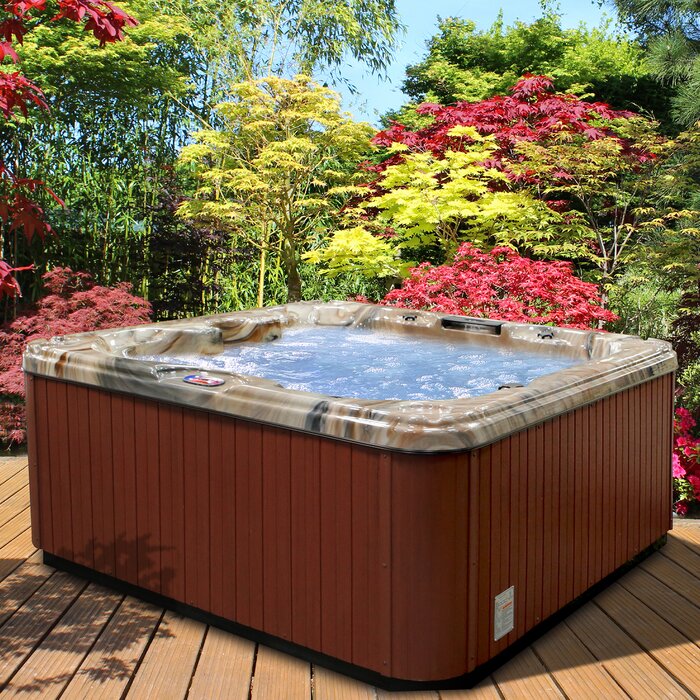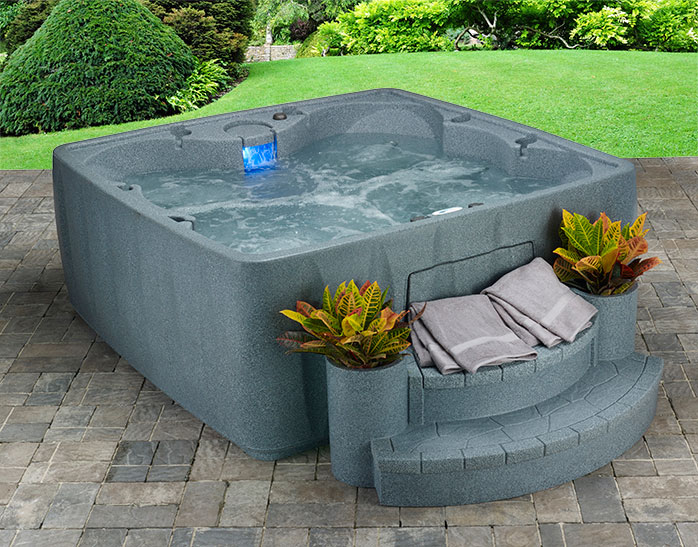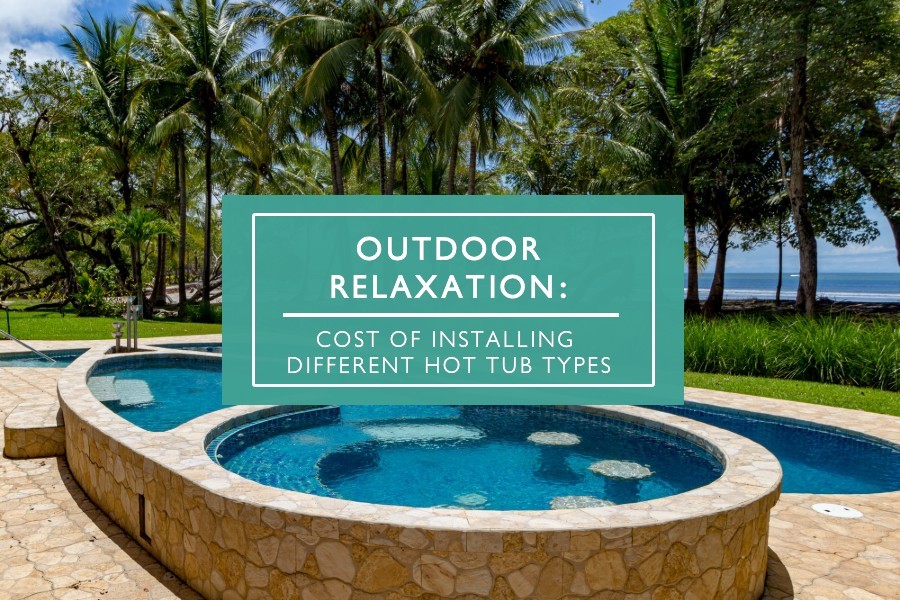Not only can you use your backyard for hosting small gatherings and BBQ parties or doing outdoor activities with the family, but it can also be a space for you to lounge and relax in.
It’s nice to have a private backyard retreat where you can unwind after a long day. One way to create this space is to install a hot tub. It is an aesthetic addition that can add value to a home. With this feature, you can have a simple outdoor relaxation area where you can drown your worries away.
There are different types of hot tubs you can get for your home. It's important to consider one that will fit with your outdoor area’s design so that it won't look awkward or like it’s just an afterthought. To help you create the perfect oasis in your yard, here are the different hot tub types and cost of each one.
In-Ground Hot Tub
Also called a custom-made hot tub, this type is installed in the ground and made out of hard materials such as concrete, stainless steel, tile, fiberglass, and copper. It is usually built with or adjacent to an in-ground pool, but some people get just the hot tub constructed, especially if they have limited backyard space.
A custom hot tub is more suitable for those who prefer a specific design or want one that will beautifully match with their landscape design. Besides customizability and durability, an in-ground hot tub is also quieter than other types since the machine that runs it can be placed far away.

But there are also in-ground hot tubs that are not custom-made. You can get prefabricated hot tubs, which are shells usually made of stainless steel or acrylic, lowered into the ground. It comes in different designs such as round, kidney, oval, or square. But with prefabricated in-ground hot tubs, you will have limited design options and seating. It usually seats around less than 10 people and may not look seamless with your yard’s appearance. You would probably have to make some changes in the landscape so that it won’t be out of place.
But with this type, you would have to carefully decide the location since it’s a permanent fixture. Most of the time, in-ground hot tubs are placed farther away from the house, which makes it less convenient. It would also be difficult to modify if ever you decide to add a new feature in the future.
Some of its other drawbacks are longer installation and higher price tag. It could take 10 to 12 weeks, depending on the complexity, but it can also just be for a few weeks if it’s a simple hot tub. It is also more expensive since it is usually a custom job that requires a contractor and construction permit. The cost ranges from $5,000 to $30,000, depending on the size, complexity, and features. It also has higher operation costs, such as heating, and maintenance expenses.
Above Ground Hot Tub
An easy way to create your outdoor relaxation area without construction is getting an above ground hot tub. Also called portable hot tubs, this type can either be inflatable or made out of solid materials such as acrylic, vinyl, or fiberglass. Inflatable ones are usually made out of Inflated latex, polyester, or other plastics.
Besides sticking out of the ground, another major difference of above ground hot tubs from in-ground ones is that it’s standalone or self-contained. This means that the machinery needed to operate the hot tub is part of the hot tub itself, hence, it’s portability. But do note that even if they can be moved to a new location, they are still heavy and will require a lot of effort to move. You will also need to consider the electrical connection when relocating or choosing a location.
Some homeowners prefer above ground hot tubs because it can be placed near the house. This is an important factor to considers, especially for those who live in a colder climate. You don’t want to walk far in freezing weather just to get to the hot tub.

Source: Wayfair
Even if portable hot tubs are not custom-made, you still have multiple options for the design since it comes in a variety of sizes, shapes, and colors with multiple features and seating configurations. You can also get cover lifters, which utilizes a lever system to make it easier to take off the cover.
Other advantages of above ground hot tubs over in-ground ones are it’s easier to maintain, faster to install, and less expensive. It is easy and quick to install since you will just need a solid foundation such as a deck or concrete surface where it can be placed on. A solid material hot tub can be installed in a few days while an inflatable one can be set up in a few hours. It takes longer to install an above ground hot tub made out of solid material since it usually requires electrical work while most inflatables one can be plugged in a normal outlet.
Source: Biglots
Portable hot tubs are also less expensive, with ones made out of solid material ranging from $3,000 to $15,000, and inflatable ones for less than $1,000 up to $4,000. Above ground hot tubs can still be expensive, depending on the size, material, and features. There are ones that come with multiple water jets for massage, Bluetooth music system, or be Wi-Fi enabled.
One drawback you will just have to consider is that it won’t integrate aesthetically as well as in-ground pools. For some people, it negatively affects the visual appeal of a backyard and sticks out like a sore thumb.
If you decided to go for an above ground hot tub but can’t decide between an inflatable or solid material one, here are the pros and cons of each.
Solid Material Hot Tub vs. Inflatable Hot Tub
SOLID MATERIAL
Pros
Cons
INFLATABLE
Pros
Cons
Wooden Hot Tub
If you prefer a traditional hot tub with a rustic appearance, you can get a wooden hot tub. In the past, wooden hot tubs ran on a wood fire, but now, it can also be heated using gas, electricity, or a combination of these power sources. Carefully consider which heating source you will get since it will determine how quickly the hot tub will heat up as well as its location.
A wood-fired hot tub demands a lot of preparation but you can place it anywhere. You will just have to check if you require a permit for burning wood. Another issue with this heating source is that you will constantly need to add wood to maintain the heat. This means you will need to get out mid-use, which will be inconvenient. That’s why gas- or electrical-powered wooden hot tubs are more popular nowadays.

Source: Roberts Hot Tubs
This hot tub was originally intended for personal use, but modern models are now larger and have better seating configurations. Wooden hot tubs are typically above ground but they can also be semi-inground. While above ground hot tubs are usually considered not visually appealing, it’s a different case for an above ground wooden hot tub due to its old-fashioned charm. It can be made out of redwood, cedar, cypress, oak, and teak. Most people prefer cedar or redwood since it produces a natural aroma when the hot tub becomes hot and wet.
Wooden hot tubs are heavy and bulky, and deeper than modern hot tubs. They usually offer fewer jets, lights, and controls, and other fun features you see in newer hot tub models. Even without these, it still doesn’t make the installation easier or the price lower. A wooden hot tub usually costs around $2,500 to $10,000, depending on the size, wood, heating source, and features.
Exercise Pool Hot Tub
If you want to swim but don’t have enough space for a swimming pool, you can get an exercise pool hot tub or a swim spa (related: Swim Spa Pros & Cons). This is a large hot tub where you can swim, float, and exercise in. They have powerful jets, and some models can even create a current that you can swim against, like a treadmill but for swimming. This type is bulky and usually above ground, which requires a solid foundation such as a deck to be placed on, but they can also be in-ground. If you get the above ground exercise pool hot tub, it will also be a standalone unit which means it has the machinery built within the hot tub.

Source: Imagine Backyard Living
Since they are large, you will still require more space than you need for traditional hot tubs. Exercise pool hot tubs are also expensive, costing around $9,000 to $50,000. If you want to swim against a stronger current, you can get a model with a propeller instead of jets for the current. These ones would cost $25,000 or more. You would also have to spend more on operating costs since you will need more water and electricity for heating.
Rotomolded Hot Tub
One of the most affordable hot tub options is a rotationally molded hot tub. It is a durable type made out of polyethylene, which is a material commonly used for water bottles and kayaks. While it comes in a variety of sizes and shapes, they don’t look as aesthetically pleasing as other types of hot tubs and may appear duller due to the lack of color options. It often has custom seating, which makes it comfortable despite the lack of visual appeal.

Source: AquaRest Spas
A rotomolded hot tub comes in one piece and often includes a variety of features, but you will not be able to customize it if you want to add jets, shelves, cabinets, or an entertainment system. This type is usually placed above ground and only needs a normal outlet to run. It is also lightweight, so two to three people can easily move it.
If you don’t need a high-end hot tub with all the works, you can create a simple outdoor relaxation area on a budget with a rotomolded hot tub. This type of hot tub costs around $2,000 to $6,000.
LOOKING FOR A CONTRACTOR?


